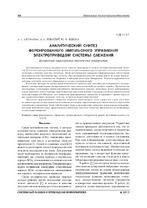| dc.contributor.author | Абуфанас, А. С. | ru |
| dc.contributor.author | Лобатый, А. А. | ru |
| dc.contributor.author | Яцына, Ю. Ф. | ru |
| dc.coverage.spatial | Минск | ru |
| dc.date.accessioned | 2018-02-08T08:05:29Z | |
| dc.date.available | 2018-02-08T08:05:29Z | |
| dc.date.issued | 2017 | |
| dc.identifier.citation | Абуфанас, А. С. Аналитический синтез форсированного импульсного управления электроприводом системы слежения = Analytical synthesis of forced pulse electronic drive control of a tracking system / А. С. Абуфанас, А. А. Лобатый, Ю. Ф. Яцына // Системный анализ и прикладная информатика. - 2017. – №4. - С. 16-20. | ru |
| dc.identifier.uri | https://rep.bntu.by/handle/data/37437 | |
| dc.description.abstract | Рассматривается задача аналитического синтеза управляющего сигнала линейной динамической системой. В качестве критерия оптимизации предлагается рассматривать время перехода системы из начального состояния в заданное конечное состояние. Такой вид управления называется форсированным, обеспечивающим максимальное быстродействие системы. Рассматривается решение данной задачи на основе применения неопределенных множителей Лагранжа и принципа максимума Понтрягина. Получены выражения для матрицы переходов системы и управляющего сигнала в векторном виде. В качестве примера для оценки работоспособности предлагаемой методики рассматривается электропривод, описываемый широко распространенной математической моделью второго порядка. Представлены качественные иллюстрации работоспособности предлагаемого подхода, полученные путем моделирования в среде Mathcad и количественные характеристики изменения входных и выходных сигналов гипотетической системы управления. Показано, что применение форсированного управления не приводит к выходу переменных, характеризующих состояние системы, за пределы допустимых значений. Применение форсированного управления позволяет синтезировать закон управления в виде последовательности прямоугольных импульсов постоянной амплитуды, определяемой источником питания, переменной скважности и полярности. Такой подход может быть использован при управлении вентильными электродвигателями постоянного тока, применяемыми в различных системах слежения, применяемых на беспилотных летательных аппаратах. | ru |
| dc.language.iso | ru | ru |
| dc.publisher | БНТУ | ru |
| dc.subject | Форсированное управление | ru |
| dc.subject | Целевая функция | ru |
| dc.subject | Электрический привод | ru |
| dc.subject | Последовательность импульсов | ru |
| dc.subject | Forced control | en |
| dc.subject | Target function | en |
| dc.subject | Electric drive | en |
| dc.subject | Pulse train | en |
| dc.title | Аналитический синтез форсированного импульсного управления электроприводом системы слежения | ru |
| dc.title.alternative | Analytical synthesis of forced pulse electronic drive control of a tracking system | en |
| dc.type | Article | ru |
| local.description.annotation | The problem of analytical synthesis of a control signal by a linear dynamical system is considered. As an optimization criterion, it is proposed to consider the transition time of the system from the initial state to a given final state. This type of control is called forced, providing the maximum system speed. The principle of solving this problem is considered on the basis of application of uncertain Lagrange multipliers and the Pontryagin maximum principle. Expressions are obtained for the matrix of transitions of the system and the control signal in a vector form. As an example, the electric drive described by the widespread second-order mathematical model is considered to evaluate the efficiency of the proposed method. Qualitative illustrations of the operability of the proposed approach, obtained by modeling in the Mathcad environment, and quantitative characteristics of the change in the input and output signals of the hypothetical control system are presented. It is shown that the use of forced control does not lead to the output of variables characterizing the state of the system, beyond the limits of admissible values. The use of forced control makes it possible to synthesize the control law in the form of a sequence of rectangular pulses of constant amplitude determined by the power source, variable duty cycle and polarity. This approach can be used for the control of DC-type DC motors used in various tracking systems used on unmanned aerial vehicles. The use of forced control makes it possible to synthesize the control law in the form of a sequence of rectangular pulses of constant amplitude determined by the power source, variable duty cycle and polarity. This approach can be used for the control of DC-type DC motors used in various tracking systems used on unmanned aerial vehicles. | en |

